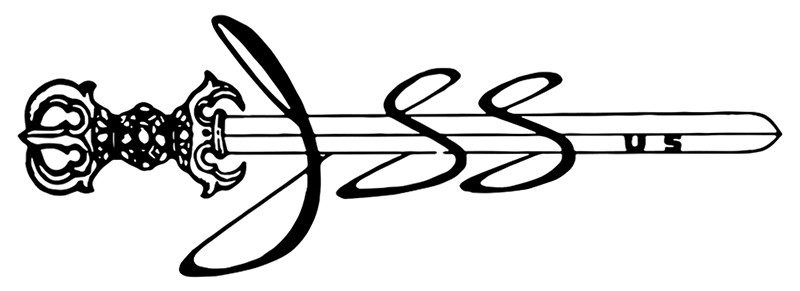
The articles on this page originally appeared in JSSUS newsletter Volume 8, no.1, 1969.
Yasuchika - A Lecture by John Yumoto- Page 25
Yasuchika - A Lecture
by John Yumoto
Yasuchika was commonly called Yagohachi. In his old age he changed it to Tou, which, literally translated, means "eastern rain". He was undoubtedly one of the greatest the field of machi-bori kinko, "soft metal workers”. Anyone working in the softer metals was placed into one of three groups, with the exception of the Goto family. The kozuka makers, tsuba-ko, "tsuba makers" and machi-ko, "soft metal workers". A literal translation of machi-bori kinko is "town metal worker". Anyone not a Goto [ie-bori] was a town metal worker.
Yasuchika was born in the 10th year of Kanbun (1670), at Shōnai in Dewa Province and died at the age of 75 in 1744 in Edo. Some of his early work and some of that in his old age was done in iron. This is unusual. Usually once a worker got set in soft metals he never changed. The reason was that the tools were entirely different. Quite often, however, steel workers changed to the softer metals since they were much easier to work.
He was one of the big three machi-kō. They were Nara Toshinaga, Sugiura Joi and Tsuchiya Yasuchika. These were the three masters of Nara [Nara Sansaku].
He was employed by Matsudaira Daigaku no kami Yorisada, the lord of Moriyama Castle in Mutsu Province. He received a good salary and worked most of the time in Edo. It is not certain when he changed his name to Tou. The first dated piece signed that way was in the 11th year of Kyoho (1726), so it had to be before that. As to his style characteristics: we do not find any of his signed pieces when he was at Shōnai, but they found one Yagohachi signature. It is iron and almost like the Shoami school. I feel that he must have picked up his first training under the Shōami because that area was dominated by this school.1 They were an offshoot of the Kyoto Shoami.
After he was employed by the Matsudaira and went to Edo, he made many tsuba, and with a drastic change in his style. His trend was toward the Nara school style. Nara school is basically iron with flowers, birds and so forth.
1 Editor's note: Recent research has shown that Yasuchika first learned under Shoami Yagobei Chinkyo in Shonai then Nara Tokimasa in Edo at Kanda. He first served in the family of Daizen, Matsudaira chief retainer for Shōnai. Went to Edo in the 16th year of Genroku (1703).
He was not very strong and consequently started working only in soft metals. He was good at this, like Myoju. He knew how to design and handle colors and, for the times, his work was epoch making. He designed the Daigaku Zo, an elephant. There were quite a few tsuba of this design. Also Tokusa Kari, "the cutting of the grass": an old man cutting with a sickle and looking up at the sky, with the moon usually showing. Many artists copied this design, but none could catch the feeling and expression that he did. Then he went into historical figures, like the man with his pet tiger.1 Until recently this was known only to be in brass, but one was discovered in the United States made of iron which kicked up quite a bit of dust.
I would like to go into his successors a little, and the phonies. You see so many signed Yasuchika pieces. He had no son so he adopted one who was Yasuchika II. Yasuchika III was his son and the 4th Yasuchika was not connected with the family at all. The fifth was a student of the fourth. There was a fellow who called himself the sixth generation Yasuchika, and who was the son of the fifth. His work was fairly good and sometimes is confused with the first. They are quite good imitations. Some experts tried to identify by the signature, and when I was young we studied the strokes and so forth. However, new inscriptions have kept turning up in the past 100 or 200 years. Doctor Homma said that whenever a good book is written a better one usually follows.
Speaking of certificates, many certificates are phony, but you can usually tell if you have seen an original. Doctor Sato's sayagaki has been copied. They usually copy from a photograph and some details get lost in the process. Yasuchika not only worked with tsuba but made many things not related to the sword at all. Flower vases, water pitchers, ash tray sets, tea kettles for the tea ceremony and the like.
1 Editor's note: Bukan (Feng Kan, Chinese priest).